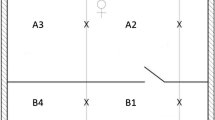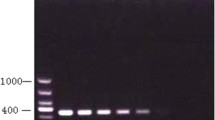Abstract
Histoplasmosis is a systemic mycosis caused by inhaling spores of Histoplasma capsulatum, a dimorphic fungus. This fungus grows in soil contaminated with bat and avian excreta. Each year, patients with disseminated histoplasmosis have been diagnosed in Chiang Mai, northern Thailand. No published information is currently available on the environmental sources of this fungus in Chiang Mai or anywhere else in Thailand. The aim of this study was to detect H. capsulatum in soil samples contaminated with bat guano and avian droppings by nested PCR. Two hundred and sixty-five samples were collected from the following three sources: soil contaminated with bat guano, 88 samples; soil contaminated with bird droppings, 86 samples; and soil contaminated with chicken droppings, 91 samples. Genomic DNA was directly extracted from each sample, and H. capsulatum was detected by nested PCR using a primer set specific to a gene encoding 100-kDa-like protein (HcI, HcII and HcIII, HcIV). Histoplasma capsulatum was detected in seven of 88 soil samples contaminated with bat guano, one of 21 soil samples contaminated with pigeon droppings and 10 of 91 soil samples contaminated with chicken droppings. The results indicate the possibility of the association of bat guano and chicken droppings with H. capsulatum in this area of Thailand.
Similar content being viewed by others
References
Edwards LB, Acquaviva FA, Livesay VT. Further observations on histoplasmin sensitivity in the United States. Am J Epidemiol. 1973;98:315–25.
Di Salvo AF, Ajello L, Palmer JW Jr, Winkler WG. Isolation of Histoplasma capsulatum from Arizona bats. Am J Epidemiol. 1969;89:606–14.
Zeidberg LD, Ajello L, Dillon A, Runyon LC. Isolation of Histoplasma capsulatum From Soil. Am J Public Health Nations Health. 1952;42:930–5.
Hay RJ. Histoplasmosis. Semin Dermatol. 1993;12:310–4.
Ajello L, Weeks RJ. Soil contamination and other control measures. In: Di Salvo AF, editor. Occupational mycoses Philadelphia: Lea and Febiger; 1983 pp. 229–38.
Bialek R, Feucht A, Aepinus C, Just-Nübling G, Robertson VJ, Knobloch J, Hohle R. Evaluation of two nested PCR assays for detection of Histoplasma capsulatum DNA in human tissue. J Clin Microbiol. 2002;40:1644–7.
Emmons CW. Isolation of Histoplasma capsulatum from Soil in Washington, D.C. Public Health Rep. 1961;76:591–5.
Cano MV, Hajjeh RA. The epidemiology of histoplasmosis: a review. Semin Respir Infect. 2001;16:109–18.
Lottenberg R, Waldman RH, Ajello L, Hoff GL, Bigler W, Zellner SR. Pulmonary histoplasmosis associated with exploration of a bat cave. Am J Epidemiol. 1979;110:156–61.
Ibarrar-Camou B, Toranzo AI, Lee W, Davel G, Canteros CE. Rapid identification of Histoplasma capsulatum in culture lysates. Rev Iberoam Micol. 2011;28:26–31.
Elías NA, Cuestas ML, Sandoval M, Poblete G, Lopez-Daneri G, Jewtuchowicz V, Iovannitti C, Mujica MT. Rapid identification of Histoplasma capsulatum directly from cultures by multiplex PCR. Mycopathologia. 2012;174:451–6.
Reid TM, Schafer MP. Direct detection of Histoplasma capsulatum in soil suspensions by two-stage PCR. Mol Cell Probes. 1999;13:269–73.
Widjojoatmodjo MN, Fluit AC, Torensma R, Verdonk GP, Verhoef J. The magnetic immuno polymerase chain reaction assay for direct detection of salmonellae in fecal samples. J Clin Microbiol. 1992;30:3195–9.
Tsai YL, Olson BH. Rapid method for separation of bacterial DNA from humic substances in sediments for polymerase chain reaction. Appl Environ Microbiol. 1992;58:2292–5.
Kikuchi K, Sugita T, Makimura K, Urata K, Someya T, Sasaki T, Kamei K, Niimi M, Hiramatsu K, Uehara Y. Is Histoplasma capsulatum a native inhabitant of Japan? Microbiol Immunol. 2008;52:455–9.
Kwon-Chung KJ, Bennett JE. Medical Mycology: Philadelphia. London: Lea and Febiger; 1992. p. 819.
Smith CD, Goodman NL. Improved culture method for the isolation of Histoplasma capsulatum and Blastomyces dermatitidis from contaminated specimens. Am J Clin Pathol. 1975;63:276–80.
Carvajal Zamora JR. Isolation of Histoplasma capsulatum from soil in the Aguas Buenos caves, Aguas Buenos, Puerto Rico. I. An ecological approach. Mycopathologia. 1977; 60: 157–61.
Ohno H, Tanabe K, Umeyama T, Kaneko Y, Yamagoe S, Miyazaki Y. Application of nested PCR for diagnosis of histoplasmosis. J Infect Chemother. 2013;. doi:10.1007/s10156-013-0548-2.
Acknowledgments
This work was supported by the Faculty of Medicine Endowment Fund for Medical Research, Faculty of Medicine, Chiang Mai University, Thailand, the grant from the Ministry of Health, Labour and Welfare of Japan (H22-shinkou-ippan-008, H23-shinkou-ippan-018, H23-shinkou-ippan-007, H24-shinkou-ippan-013, H23-shinkou-shitei-020), JSPS KAKENHI Grant Number 21390305, and a collaborative research-promoting grant (Asia) by National Institute of Infectious Diseases (NIID), Japan. We thank Mrs. Chantana Khamwan, Clinical Microbiology, Faculty of Medicine for data of histoplasmosis in Maharaj Nakorn Chiang Mai Hospital, and also thank Dr. Takashi Umeyama, Dr. Satoshi Yamagoe for their helpful discussion of this study.
Author information
Authors and Affiliations
Corresponding author
Electronic supplementary material
Below is the link to the electronic supplementary material.
Rights and permissions
About this article
Cite this article
Norkaew, T., Ohno, H., Sriburee, P. et al. Detection of Environmental Sources of Histoplasma capsulatum in Chiang Mai, Thailand, by Nested PCR. Mycopathologia 176, 395–402 (2013). https://doi.org/10.1007/s11046-013-9701-9
Received:
Accepted:
Published:
Issue Date:
DOI: https://doi.org/10.1007/s11046-013-9701-9




